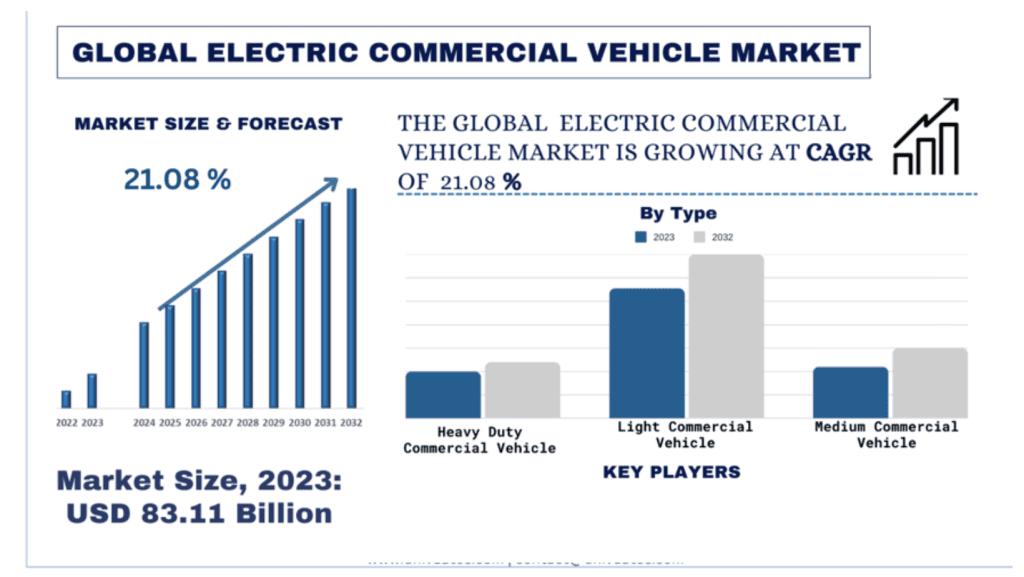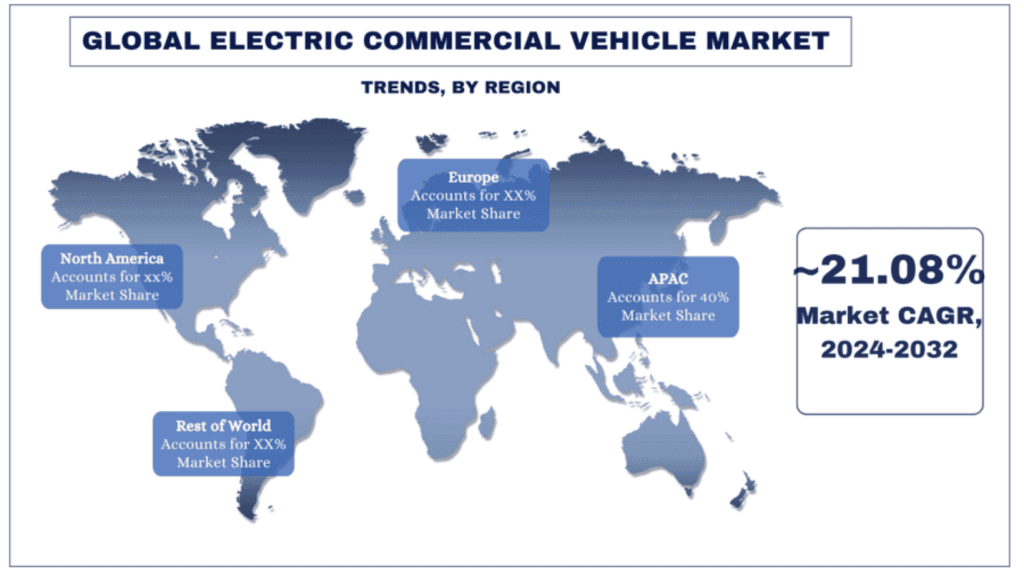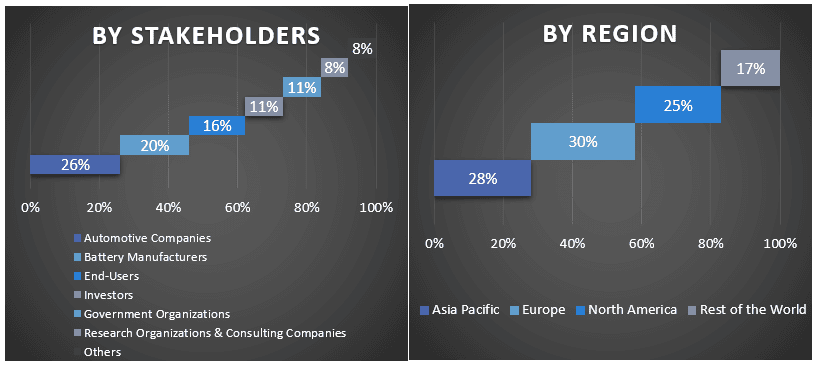- Home
- About Us
- Industry
- Services
- Reading
- Contact Us
Electric Commercial Vehicle Market: Current Analysis and Forecast (2024-2032)
Emphasis on Vehicle Type (Light Commercial Vehicle, Medium Commercial Vehicle, and Heavy-Duty Commercial Vehicle), Power Train (Battery Electric Vehicle (BEV), Hybrid Electric Vehicle (HEV), Plug-in Hybrid Vehicle (PHEV), Fuel Cell Electric Vehicle (FCEV)), Battery Capacity (Less Than 50 kWh, 50 to 250 kWh, and Above 250 kWh) and Region/Country

Electric Commercial Vehicle Market Size & Forecast
The electric commercial vehicle market was valued at USD 83.11 Billion and is expected to grow at a strong CAGR of around 21.08 % during the forecast period (2024-2032).
Electric Commercial Vehicle Market Analysis
The global electric commercial vehicle (ECV) market is experiencing a surge, driven by stringent emission regulations and growing awareness of climate change are pushing businesses and governments to adopt sustainable transportation solutions. ECVs offer a significant reduction in greenhouse gas emissions compared to traditional diesel or gasoline-powered vehicles. Moreover, battery technology is rapidly evolving, offering greater range and faster charging times. This is making ECVs a more viable option for commercial applications, where operational efficiency is crucial. Many governments are offering subsidies and tax breaks to encourage the adoption of ECVs. This financial support is helping to offset the higher upfront cost of electric vehicles compared to traditional ones
Electric Commercial Vehicle Market Trends
The electric commercial vehicle (ECV) market is a dynamic space undergoing rapid transformation. Here’s a breakdown of key trends shaping its future. Governments worldwide are enacting stricter emission standards, pushing manufacturers to develop cleaner vehicles. This favors ECVs, which produce zero tailpipe emissions. Many cities are implementing low-emission zones (LEZs) where traditional vehicles face restrictions or bans. This incentivizes businesses operating in these areas to adopt ECVs. Improvements in battery range and lifespan are crucial for wider ECV adoption. We’re seeing developments in lithium-ion battery chemistry and the potential of solid-state batteries to offer even greater range and faster charging times. Integration of autonomous driving technology with ECVs holds immense potential for optimizing logistics and delivery operations.
Asia Pacific is Expected to Grow with a Significant CAGR During Forecast Period.
Europe has emerged as a frontrunner in the global electric commercial vehicle (ECV) market, driven by a confluence of factors that create fertile ground for their adoption. Here’s a deeper dive into why Europe is experiencing significant growth in this sector. EU Emission Reduction Targets: The European Union (EU) has imposed aggressive emission reduction targets for vehicles. These regulations push manufacturers to develop cleaner alternatives, making ECVs a compelling solution. Several European countries like Norway, Netherlands, and Denmark are planning bans on the sale of new ICE vehicles in the coming years. This creates a strong incentive for businesses to shift towards ECVs. Subsidies and Tax Breaks: European governments offer various financial incentives to promote ECV adoption. These include subsidies on purchase price, tax breaks on registration and road tolls, and support for charging infrastructure development. Many European countries have set ambitious climate goals and view ECVs as a crucial tool for achieving them. This translates into government policies and funding initiatives that specifically support the ECV market. While Europe leads the way, these factors influencing its ECV market hold promise for broader global adoption as well.

Electric Commercial Vehicle Industry Overview
The electric commercial vehicle market is competitive and fragmented, with the presence of several global and international market players. The key players are adopting different growth strategies to enhance their market presence, such as partnerships, agreements, collaborations, new product launches, geographical expansions, and mergers and acquisitions. Some of the major players operating in the market are BYD Company Ltd, AB Volvo, Mercedes-Benz Group AG., TRATON GROUP, Nikola Corporation., Tesla, DAF, Rivian., Yutong Bus Co., Ltd., and SANY Global.

Electric Commercial Vehicle Market News
2023: Daimler Truck: Unveiled its all-electric eActros LongHaul for long-distance trucking, with a targeted range of over 500 kilometers on a single charge (expected launch in 2024).
Tesla: Announced the Semi electric truck, facing delays but aiming for volume production in 2024.
Volvo Trucks: Launched its heavy-duty electric truck range, the Volvo FH, FM, and FMX Electric, in Europe and North America.
BYD: The Chinese electric vehicle giant continued to dominate the electric bus market globally.
2024: Mercedes-Benz Vans: Announced a partnership with the Polish government to build a new production plant dedicated entirely to electric vans.
Volkswagen Group: Launched pilot testing programs for its electric delivery vans in the US and Europe.
Rivian: Announced a partnership with Amazon for the delivery of 100,000 electric delivery vans.
Ford: Unveiled its all-electric F-150 Lightning Pro electric pickup truck, specifically designed for commercial applications.
Electric Commercial Vehicle Market Report Coverage

Reasons to buy this report:
- The study includes market sizing and forecasting analysis validated by authenticated key industry experts.
- The report presents a quick review of overall industry performance at one glance.
- The report covers an in-depth analysis of prominent industry peers with a primary focus on key business financials, product portfolios, expansion strategies, and recent developments.
- Detailed examination of drivers, restraints, key trends, and opportunities prevailing in the industry.
- The study comprehensively covers the market across different segments.
- Deep dive regional level analysis of the industry.
Customization Options:
The global electric commercial vehicle market can further be customized as per the requirement or any other market segment. Besides this, UMI understands that you may have your own business needs, hence feel free to connect with us to get a report that completely suits your requirements.
Table of Content
Research Methodology for the Electric Commercial Vehicle Market Analysis (2024-2032)
Analyzing the historical market, estimating the current market, and forecasting the future market of the global electric commercial vehicle market were the three major steps undertaken to create and analyze the adoption of electric commercial vehicle in major regions globally. Exhaustive secondary research was conducted to collect the historical market numbers and estimate the current market size. Secondly, to validate these insights, numerous findings and assumptions were taken into consideration. Moreover, exhaustive primary interviews were also conducted, with industry experts across the value chain of the global electric commercial vehicle market. Post assumption and validation of market numbers through primary interviews, we employed a top-down/bottom-up approach to forecasting the complete market size. Thereafter, market breakdown and data triangulation methods were adopted to estimate and analyze the market size of segments and sub-segments of the industry pertains to. Detailed methodology is explained below:
Analysis of Historical Market Size
Step 1: In-Depth Study of Secondary Sources:
Detail secondary study was conducted to obtain the historical market size of the electric commercial vehicle market through company internal sources such as annual reports & financial statements, performance presentations, press releases, etc., and external sources including journals, news & articles, government publications, competitor publications, sector reports, third-party database, and other credible publications.
Step 2: Market Segmentation:
After obtaining the historical market size of the electric commercial vehicle market, we conducted a detailed secondary analysis to gather historical market insights and share for different segments & sub-segments for major regions. Major segments are included in the report as vehicle type, power train, and battery capacity. Further country-level analyses were conducted to evaluate the overall adoption of testing models in that region.
Step 3: Factor Analysis:
After acquiring the historical market size of different segments and sub-segments, we conducted a detailed factor analysis to estimate the current market size of the electric commercial vehicle market. Further, we conducted factor analysis using dependent and independent variables such as vehicle type, power train, and battery capacity of the electric commercial vehicle market. A thorough analysis was conducted for demand and supply-side scenarios considering top partnerships, mergers and acquisitions, business expansion, and product launches in the electric commercial vehicle market sector across the globe.
Current Market Size Estimate & Forecas
Current Market Sizing: Based on actionable insights from the above 3 steps, we arrived at the current market size, key players in the global electric commercial vehicle market, and market shares of the segments. All the required percentage shares split, and market breakdowns were determined using the above-mentioned secondary approach and were verified through primary interviews.
Estimation & Forecasting: For market estimation and forecast, weights were assigned to different factors including drivers & trends, restraints, and opportunities available for the stakeholders. After analyzing these factors, relevant forecasting techniques i.e., the top-down/bottom-up approach were applied to arrive at the market forecast for 2030 for different segments and sub-segments across the major markets globally. The research methodology adopted to estimate the market size encompasses:
- The industry’s market size, in terms of revenue (USD) and the adoption rate of the electric commercial vehicle market across the major markets domestically
- All percentage shares, splits, and breakdowns of market segments and sub-segments
- Key players in the global electric commercial vehicle market in terms of products offered. Also, the growth strategies adopted by these players to compete in the fast-growing market.
Market Size and Share Validation
Primary Research: In-depth interviews were conducted with the Key Opinion Leaders (KOLs) including Top Level Executives (CXO/VPs, Sales Head, Marketing Head, Operational Head, Regional Head, Country Head, etc.) across major regions. Primary research findings were then summarized, and statistical analysis was performed to prove the stated hypothesis. Inputs from primary research were consolidated with secondary findings, hence turning information into actionable insights.
Split of Primary Participants in Different Regions

Market Engineering
The data triangulation technique was employed to complete the overall market estimation and to arrive at precise statistical numbers for each segment and sub-segment of the global electric commercial vehicle market. data was split into several segments & sub-segments post studying various parameters and trends in the areas of the type, technology, component, and end-user in the global electric commercial vehicle market.
The main objective of the Global Electric Commercial Vehicle Market Study
The current & future market trends of the global electric commercial vehicle market were pinpointed in the study. Investors can gain strategic insights to base their discretion for investments on the qualitative and quantitative analysis performed in the study. Current and future market trends determined the overall attractiveness of the market at a regional level, providing a platform for the industrial participant to exploit the untapped market to benefit from a first-mover advantage. Other quantitative goals of the studies include:
- Analyze the current and forecast market size of the electric commercial vehicle market in terms of value (USD). Also, analyze the current and forecast market size of different segments and sub-segments.
- Segments in the study include areas of the vehicle type, power train, and battery capacity.
- Define and analysis of the regulatory framework for the electric commercial vehicle
- Analyze the value chain involved with the presence of various intermediaries, along with analyzing customer and competitor behaviors of the industry.
- Analyze the current and forecast market size of the electric commercial vehicle market for the major region.
- Major countries of regions studied in the report include Asia Pacific, Europe, North America, and the Rest of the World
- Company profiles of the electric commercial vehicle market and the growth strategies adopted by the market players to sustain in the fast-growing market.
- Deep dive regional level analysis of the industry
Frequently Asked Questions FAQs
Q1: What is the current market size and growth potential of the electric commercial vehicle market?
Q2: What are the driving factors for the growth of the electric commercial vehicle market?
Q3: Which segment has the largest share of the electric commercial vehicle market by type?
Q4: What are the emerging technologies and trends in the electric commercial vehicle market?
Q5: Which region will dominate the electric commercial vehicle market?
Related Reports
Customers who bought this item also bought










